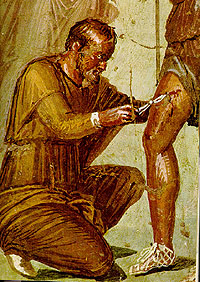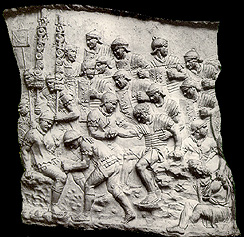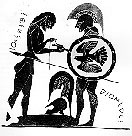Wall painting from Casa di Sirico, Pompeii, 1st Century BCE: Aeneas
receiving medical attention from Iapyx
A wounded Aeneas is carried off the battlefield and taken to the
physician to remove the dart from his thigh with forceps. |
The Roman poet Virgil (70-19 BCE) composed an epic poem, titled the
Aeneid, about the events leading up to the foundation of Rome. It
follows the adventures of the Trojan hero Aeneas who was forced to do
battle with the native inhabitants of Italy upon immigrating there from
Troy. In one of the climactic scenes at the poem’s conclusion (Aeneid
XII.383-440), Aeneas is wounded in the thigh by an arrow shaft hurled by
an anonymous soldier in the enemy camp. After the wounded Aeneas is helped
back to camp, the surgeon Iapyx comes to Aeneas’ aid by using forceps to
remove the arrow. Since the surgeon is unable to withdraw the shaft,
Venus, Aeneas’ divine mother, intervenes. From across the Mediterranean at
Mt. Ida near Troy, she brings dittany, an unknown herb to heal the wound.
Cicero, in the philosophical treatise De Divinatione, says that dittany
was supposed to make arrows fall out of goats’ bodies. Although he was
unable to help Aeneas, Iapyx was given his skill by Apollo himself to
practice ingloriously the “silent arts”, i.e., medicine. Apollo’s three
realms are music, prophecy and healing. Only in the first two is the voice
used, hence medicine is the silent art. The idea of obscurity is included
because the profession of medicine does not lead to great fame.
|




